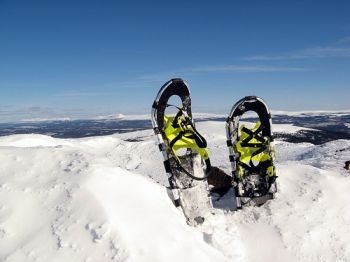How To Pick Snowshoes
 People have been strapping snowshoes onto their feet for centuries to help them navigate across large snowy patches of ground more easily and without sinking deep into the powder with every step.
People have been strapping snowshoes onto their feet for centuries to help them navigate across large snowy patches of ground more easily and without sinking deep into the powder with every step.
Today, snowshoes are not only a practical way to hike during snowy winter months, but is also a great way to get outside and get a solid workout even in the dead of winter.
Growing up in Colorado, where sunny days often follow snowstorms, having the right pair of snowshoes was a great way to get out and enjoy the fresh white blankets of sparkling snow in the beautiful Rocky Mountain wilderness.
Picking the right pair of snowshoes for your needs is obviously important. There are different kinds of snowshoes out there for different types of terrain. Recreational snowshoes are intended for relatively flat terrain like golf courses, parks, and hiking trails. Mid-level hiking snowshoes are a step up from recreational snowshoes and are intended for hiking on rolling to steep terrain. Advanced/backcountry snowshoes are made for steep and icy mountainous conditions. Lastly, running snowshoes are specially designed for trail running on packed snow.
Recreational Snowshoes
Recreational snowshoes are perfect for casual snowshoers who plan on spending most their time on moderate terrain, such as packed trails, rolling hills, and firm snow. Recreational models typically have easy to adjust bindings and less aggressive traction systems plus they are usually the least expensive models.
- Tubb’s Women’s Frontier Snowshoes
- Redfeather Hike Snowshoes
- Tubb’s Venture Men’s Snowshoes
- Atlas Elektra 1023 Women’s Snowshoes
Mid-Level Hiking Snowshoes
Hiking and all-terrain snowshoes are more rugged than recreational models and work well for moderate day hikes both on- and off-trail. They’re equipped to handle steeper terrain, although you’ll want backcountry models if you regularly take on challenging ascents. Hiking snowshoes suffice for the majority of winter day hikers though.
- Redfeather Stride Women’s Snowshoes
- Redfeather Alpine 30 Snowshoe
- MSR Denali Evo Ascent
- Tubb’s Wilderness Series Women’s Snowshoe
- Yukon Charlie’s Pro-Guide V 825 Snowshoes
Advanced/Backcountry Snowshoes
Backcountry snowshoes are designed to tackle steeper terrain, especially off-trail routes with unpacked snow. They are also designed to handle longer distances. Backcountry snowshoes offer the most flotation, aggressive traction for steep ascents and descents, and bindings that accommodate larger footwear (like mountaineering, ski, or snowboard boots if you use them when backcountry skiing or boarding). Backcountry models tend to be the most expensive due to their more technical features and stronger materials.
- Tubb’s Mountain Snowshoe
- Tubb’s Ridgeline Women’s Snowshoes
- Atlas Elektra Mountain Women’s Snowshoes
- Crescent Moon Gold Series 10
- Redfeather Guide Series
Running Snowshoes
While I have to admit that this is not the type of snowshoeing I enjoy, it is something my runner father likes to do during the winter months. The lighter weight and smaller models are tapered to allow you to run with your natural stride over packed or groomed trails. Snowshoe running is a great winter workout that burns even more calories than regular running.
Other Tips For Picking the Right Snowshoe
Sizing
Snowshoes come in a wide variety of sizes and lengths. The basic rule of thumb to remember is that the larger a snowshoe’s dimensions (length and width), the greater the amount of surface area underfoot, which is the key to not sinking into the snow. In other words, the more surface area your snowshoes have, the more flotation you have.
Manufacturers offer some models of snowshoes in several different lengths. What size snowshoes you choose depends on a combination of two factors—your weight and the snow conditions you plan on snowshowing in.
Other important features to consider
Frames and Decking: While the original snowshoes were made from wooden frames, snowshoes today are usually made out of aluminum or plastic. This has made them both lighter and easier to maintain.
Bindings: Snowshoes either come with fixed or pivoting bindings. How you plan to use your snowshoes will determine which bindings best suit your needs. Most snowshoe bindings are built to accommodate a variety of different footwear styles, but keep in mind some snowshoe bindings are built to specifically hold in heavier ski boots or more sleek running shoes.
[Photo by m.prinke on flickr]